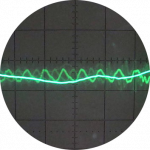Ecodan - is there actually such a thing as a 'minimum' flow temp to avoid cycling, and why if so?
Aren't you potentially confusing two things here. OP could of course increase rad size/ volume and reduce ft but that won't change the minimum output required because that's determined by the house. So unless the min output of the heat pump reduces with reduced ft,
@jamespa The first thing I’m trying to achieve is to reassure that cycling is not necessarily harmful at these low temperatures.
Regarding low flow temperatures that’s exactly what im saying - lower flow temps - that means the home has a greater potential to operate at a lower flow temperature. It would still need to operate at or above its minimum output but there is a greater chance that the heat loss of the house would match the heat gains of the lower flow temperature. I’m well aware that we’ve been here before. We have had quite extensive discussion on this and based on your more recent posts I thought you had now accepted that radiator size does help overcome cycling without overheating the home by simply allowing the whole system to operate slower and lower in line with the heat losses. And still be within a nominal DT5 and fully within the control of the accurate WCcurve.
If the HP is sized correctly the scope of modulation should be able to cope with this minimum output. Obviously this would not work if the HP is oversized to such an extent that the minimum output would still overheat. But we are talking about a 6kw HP. So of course…. I have then asked for clarification on the system, volume and capacity being used.
I’m sure @rhh2348 will find these comments useful!
Posted by: @sunandair@jamespa The first thing I’m trying to achieve is to reassure that cycling is not necessarily harmful at these low temperatures.
Very much agree. I think OP is over-concerned about this because, as you say, cycling is 'designed in'.
Posted by: @sunandairIf the HP is sized correctly the scope of modulation should be able to cope with this minimum output. Obviously this would not work if the HP is oversized to such an extent that the minimum output would still overheat. But we are talking about a 6kw HP.
Also very much agree
Posted by: @sunandairWe have had quite extensive discussion on this and based on your more recent posts I thought you had now accepted that radiator size does help overcome cycling without overheating the home by simply allowing the whole system to operate slower and lower in line with the heat losses. And still be within a nominal DT5 and fully within the control of the accurate WCcurve.
We may be splitting hairs. Larger radiators = lower flow temperature and larger system volume. The latter certainly would be expected to reduce cycling frequency, but (unless you heat the house to a different temperature) doesn't change the heat loss of the house and therefore doesn't change materially the outside temperature at which cycling starts to occur (there will be minor changes because the minimum output of the heat pump will vary a bit with flow temperature, usually upward as FT decreases but not on all spec sheets I have seen). Although it will reduce the cycling frequency the on/off ratio should remain pretty much the same at any given demand, because the ratio of demand to minimum output is not materially changed. I would expect there to be some detailed variations however because of the way heat pumps appear to modulate their compressors during the start up phase, which is obviously significant if cycling is occurring with a short period.
4kW peak of solar PV since 2011; EV and a 1930s house which has been partially renovated to improve its efficiency. 7kW Vaillant heat pump.
Posted by: @jamespaWe may be splitting hairs. Larger radiators = lower flow temperature and larger system volume. The latter certainly would be expected to reduce cycling frequency, but (unless you heat the house to a different temperature) doesn't change the heat loss of the house and therefore doesn't change materially the outside temperature at which cycling starts to occur (there will be minor changes because the minimum output of the heat pump will vary a bit with flow temperature, usually upward as FT decreases but not on all spec sheets I have seen). Although it will reduce the cycling frequency the on/off ratio should remain pretty much the same at any given demand, because the ratio of demand to minimum output is not materially changed. I would expect there to be some detailed variations however because of the way heat pumps appear to modulate their compressors during the start up phase, which is obviously significant if cycling is occurring with a short period.
Hi, This set of comments all appear to be set in theory rather than making specific answers.
for instance when you say “lower flow temperature and larger system volume… certainly would be expected to reduce cycling frequency”
How specifically might it reduce cycling? What do you know about how volume “helps” with cycling? This is a sentence I’ve seen you use before without a how attached to it.
I also find that some (not all) of your interjections on these forums seem to kill conversations rather than enabling and encouraging OPs to continue to discuss issues. It’s as though you insist on having the last word.
in my post above I set out some basics to give some tangible support the purpose being to open up the way for Mor information and hopefully more helpful comments. However, I believe your doubting opinions which are not supported with hard fact just serve to put people off.
maybe it would help if there was less interjection and see what transpires from discussions.
Posted by: @sunandairHi, This set of comments all appear to be set in theory rather than making specific answers.
for instance when you say “lower flow temperature and larger system volume… certainly would be expected to reduce cycling frequency”
How specifically might it reduce cycling? What do you know about how volume “helps” with cycling? This is a sentence I’ve seen you use before without a how attached to it
The full sentence was
"larger radiators = lower flow temperature and larger system volume. The latter certainly would be expected to reduce cycling frequency".
This is theory but is frequently stated by many, not so far as I am aware disputed, and has a simple basis namely: with a larger system volume it will take longer (at any given set of conditions) for the heat pump to heat the water in the system from the lower hysteresis limit to the higher hysteresis limit. Thus the cycling period will increase (or equivalently the cycling frequency will reduce). Obviously one can do a calculation of the predicted effect and thus be more specific, but going into that seemed like too much detail at this satge.
Posted by: @sunandairin my post above I set out some basics to give some tangible support the purpose being to open up the way for Mor information and hopefully more helpful comments. However, I believe your doubting opinions which are not supported with hard fact just serve to put people off.
I actually said 'Very much agree' to two out of three of your tangible suggestions, with the intent of amplifying them for the benefit of OP.
The one I contested was the benefits of increasing radiator size given that this is an extensive undertaking and OP appears to be concerned about cycling not COP. The simplest way that I know to improve cycling in that situation is surely to add a volumiser. I am sorry if agreeing on two points but disagreeing (in part) on one was offensive.
Posted by: @sunandairmaybe it would help if there was less interjection and see what transpires from discussions.
I agree with this, however it is the nature of this forum that multiple people like or choose to offer help/facts/opinions and this inevitably generates discussion, particularly where there are contradictory views or, more likely, just an (apparent) lack of clarity. I cant realistically see how that can be avoided.
I try only to intervene in three cases
- I have something new to add which I think is of practical use
- I believe someone else has said something which is either not clear or might mislead OP
- Sometimes, I I think it will help, I want to amplify what someone else has said for the benefit of the OP, in which case I generally either give the whole post a thumbs up or make a short comment like 'very much agree'
Perhaps I spend to much time on this forum!
4kW peak of solar PV since 2011; EV and a 1930s house which has been partially renovated to improve its efficiency. 7kW Vaillant heat pump.
Posted by: @jamespaI actually said 'Very much agree' to two out of three of your tangible suggestions, with the intent of amplifying them for the benefit of OP.
The one I contested was the benefits of increasing radiator size given that this is an extensive undertaking and OP appears to be concerned about cycling not COP. The simplest way that I know to improve cycling in that situation is surely to add a volumiser. I am sorry if agreeing on two points but disagreeing (in part) on one was offensive.
So James I’m sure you might realis that my first 2 points were giveaway comments - ones that you couldn’t really object to. So your agreement is somewhat expected.
The third point was obviously the central point of my post. And your reason for querying it was that you didn’t think the OP was interested in COP. Well that was not my view.
You appear to have overlooked that the OP was concerned about being able to operate his system at 30c…. That, to my mind is someone very interested in operating as efficiently as possible. I gave due consideration to the OPs post and made what I consider to be the right call.
So perhaps your interjection, as I have already asserted was premature and perhaps unnecessary.
@rhh2348 it’s clear you are wanting to run your heat pump at a low flow rate ie 30c. But you are also aware of some of the limitations of operating at low flow temperatures.
however one significant behaviour of operating at at low flow temperature is the HP will only be able to continue operating at the WCcurve set flow temperature if the return temperature water has dropped enough to allow a reasonable DT. (this also applies to the fixed flow temperature mode)
NB This is why you might see the HP decide to operate at a higher flow temperature than your set point because the return temp is forcing it to go higher to create the required minimum DT.
So in my experience of the ecodan it is not the failure of the HP to modulate lower, as your comments have stated but the operating requirements of the system to operate at a workable DT. The controls are sophisticated enough to establish when it needs to pause operation and it raises its flow temperature to allow the short pause to not affect thermal gain in the home.
I have copied part of my post from earlier in the week. See below.
if you are interested in finding out more please give some more information about your specific system as requested below and perhaps also include:
Thermal properties of your home
Total system volume
(which from one of your earlier comments may be out of step with recent and more progressive thoughts on best installation practice.)
Emitter type
Emitter volume
general controls, plumbing variants, pumps LLH, cylinder type etc all helps to give a fuller picture.
Posted by: @sunandairtotal radiator volume is crucial to operating at lower flow temps because you need to be able to ditch the minimum kw of 3kw or 3.2kw in your HP size case. And system volume is also very important to carry it and overcome defrost scenarios in colder weather.
If the radiator cannot lose the required heat then the return temperature comes back too high, squeezing the DT until the Lowish flow temp cannot be maintained any more. So it has to cycle. If you have a large enough emitter capacity then the minimum HP output can be satisfied at the lower temperature flow temp you are looking for. The lower flow temp also means your room temperature is not going to be reached too quickly, so avoiding room stat shutdown.
Does this make any sense?
Can you list your total system volume and DT50 rating of all your radiators/UFH? This might help clarify if you’re light in capacity.
I also attach a graph showing the minimum output of your heat pump which shows its minimum output at different outdoor temperatures. When you are operating close to the minimum output small variations in gas or construction may result in earlier or later shutdown times.
I also draw your attention that the graph only goes down to 35c flow temperature so at 30c you could assume the minimum output threshold will be higher than the graph.
I hope you can offer some more information
I've requoted the previous responses - if demand is increasing then some heat is better than no heat of cycling, surely? If the LWT isn't high enough to satisfy the demand, at least some part of it would be - unless the software has to cycle to go again before it can try another way of satisfying the demand (as SUNandAIR alludes to later on)?That would overheat the house. If house demand is less than min output it must either cycle or overheat the house.DT rising (at constant water flow rate) would indicate an increased demand not a reduced demand.It should, however I imagine it's actually just a too-aggressive algo; logic would say that the unit should stay at the maximum flow temp to keep it running rather than cycle in that situation - i.e. if demand is still there, give what heating it can rather than none!?
If I can get to the point I understand why the software ramps up too fast then cycles (more to follow), fair enough, however my logic was, at the point where the dT is borderline too large, a pump that could increase flow a little would increase the RWT a little and allow it to continue? I believe that is how the newer HPs from other manufacturers work?That won't necessarily help. The key is not DT it's min compressor output.invest in a pump that can change flow rate based on flow setpoint or dT...
That is very true - it feels like this is a known weakness of the EcodansYou need either a heat pump with a wider modulation ratio
From my calculations, it would appear that my 6kW is *undersized* (by approx 10%) for the property's heat loss so probably the modulation from these two.or one with a max output better matched to your house if cycling is to reduce
As the 6kW and 8.5kW Ecodans are the same unit (a dipswitch changes between power outputs), I suspect the 6kW is suffering at the lower flow temps as the '8.5kW' hardware can't modulate that low - the 5kW minimum capacity at 2C OAT and 35 LWT is 2.5 vs 3.4 for the 6/8.5 - a figure of 2.9/3 would help here I'd say.
I know why you say that but, having a quick look back over the past few weeks of data only, I can see cycles as little as eight minutes in length.First thought is that cycling is a designed in process. And Mitsubishi appears to to have a 20 minute minimum run time for normal operation with 3 to 5 minute off time between cycles.Posted by: @sunandair
Logically, the lower frequency = more gentle, yes, but isn't the main wear/damaging issue here the stopping then restarting, and possibly the 'burst' stress on other components during the restarting?this means that at 30c flow temp the temps are gentle on the compressor. And if the restart is only 3 to 5 minutes away the restart temp is still up at around 26c. So it is generally believed that cycling at these low temperatures and low temp differences is less stressful than perceived.
From memory, I think I agree, however I'd say it needs significant refinement as to how it does this.it may not adjust in a conscious way( if it were you or I in control.) but the algorithm appears to be searching for the best flow temp based on WCC is asking for. And if it can’t sustain operation at the flow temp requested it deliberately raises its flow temp for 6 or 8 minutes before shutting down. To me this is consistent behaviour.
It'd be useful to know what that minimum volume is and why Mitsubishi doesn't state it, as they do other operating parametersBut you’re right- total radiator volume is crucial to operating at lower flow temps because you need to be able to ditch the minimum kw of 3kw or 3.2kw in your HP size case.
From previous calculations, I believe I have over 150 litres in the system - rads alone hold 35 litres and their DT50 output is 31kW, though at a flow temp of 33C, I calculate 1.4kW. I don't know how to calculate the equivalent for UFH.Can you list your total system volume and DT50 rating of all your radiators/UFH? This might help clarify if you’re light in capacity.
Posted by: @rhh2348If I can get to the point I understand why the software ramps up too fast then cycles (more to follow), fair enough, however my logic was, at the point where the dT is borderline too large, a pump that could increase flow a little would increase the RWT a little and allow it to continue? I believe that is how the newer HPs from other manufacturers work?
The point to understand is that cycling basically occurs because the heat demand from the house is less than the minimum that the compressor can produce. So the way the heat pump deals with this is to turn on and off (cycle) so that the average heat produced equals the demand.
Increasing or reducing flow doesn't really affect the compressor limits or the heat demand from the house. If the demand is only marginally above/below the compressor minimum this might make a difference, but that will only occur over a narrow outdoor temperature range so won't materially affect the big picture which is determined by the compressor and the house.
Does that make it clearer?
As to why the heat pump initially sets a higher compressor modulation than what it settles down to, I don't really know but suppose it's to do with the controller trying to get to the set flow temp as soon as possible (IE it's a design decision).
4kW peak of solar PV since 2011; EV and a 1930s house which has been partially renovated to improve its efficiency. 7kW Vaillant heat pump.
As I stated in the OP, I want to understand (and try to rectify) the operating inconsistencies - short-cycling can occur throughout the night with a restart/run/stop/wait repeat every 25 minutes under very similar conditions described previously, which can't be right.I think OP is over-concerned about this because, as you say, cycling is 'designed in'.
My heat loss calcs suggest, even at a higher flow temp that I'm running now, my rads are too small but at the same time, the current flow through them seems to need to be very low (for the current flow temp) - if I increase the size of the rads, the output will go up but I should be able to lower the flow temp - how can I know that larger always means flow temp can be reduced more/rather than flow volume/rate? or by asking the question, I suspect that confirms the way forward is only with a volumiser rather than larger rads...Larger radiators = lower flow temperature and larger system volume
Not so - I mention reduced efficiency in the OP. If I could reliably achieve runs > 45 mins at a time with no effect on CoP/efficiency, I probably wouldn't have posted! But the effect on CoP as a result of restarts/compressor frequency changing is dramatic.OP appears to be concerned about cycling not COP
- 26 Forums
- 2,342 Topics
- 53 K Posts
- 161 Online
- 6,000 Members
Join Us!
Worth Watching
Latest Posts
-
RE: LiFePO4 lithium battery fires and explosions
It is not AI, it was my own thinking! I was just descri...
By Batpred , 7 minutes ago
-
RE: Poll for Time of Use, tariffs, technology
@old_scientist Interesting point, but I suspect that's ...
By Sheriff Fatman , 29 minutes ago
-
RE: Different dT on each radiator?
I cant sorry. Its based on some calculations I did fro...
By JamesPa , 3 hours ago
-
RE: Setback savings - fact or fiction?
Maybe this: or maybe that the effect you are seein...
By JamesPa , 3 hours ago
-
RE: Help me keep the faith with my air source heat pump installation
@simonf thats interesting as I’ve noticed my flow and r...
By AdamK , 12 hours ago
-

RE: MELcloud scheduling misbehaviour
No, it gets to set temperature easily even during perio...
By Abernyte , 12 hours ago
-
RE: Free Ecoheat Heat Pump Install
Sorry hit 'add reply' too early, this forum layout will...
By Deltona , 13 hours ago
-
And arguably even more important, sodium will be hopefu...
By Batpred , 17 hours ago
-
RE: A Smarter Smart Controller from Homely?
I've been thinking of emailing Homely to ask for a few ...
By JohnnyB , 1 day ago
-
Max output of Heat pump (Daikin 4Kw EDLA04)
Hello, I am a bit puzzled that according to pcdb tes...
By GeorgeA , 1 day ago
-

In that case, @technogeek, I’d sign up for the free sol...
By Majordennisbloodnok , 1 day ago
-

RE: Has Anyone Else Noticed a Decline in Tradesmanship?
@cathoderay Hence my rider about ‘all else being equal’...
By Toodles , 1 day ago
-

RE: Heat Pump Performance Analysis Web App using Modbus Data
@redzer_irl — all my heat pump data is in csv files, me...
By cathodeRay , 1 day ago
-

That’s not a problem. If you can hit the main landing p...
By Majordennisbloodnok , 1 day ago
-

RE: Configuration issues with 10kW Midea R32 heat pump
@benson I believe there are quite a few of these instal...
By Toodles , 1 day ago
-
RE: 10kw heat pump run in 24*7 data?
I would say you most likely do need 10kW. My gas consu...
By JamesPa , 1 day ago
-
RE: Mitsubishi Ecodan 11kw Defrosting Issue.
@thundermink I managed to find the fault. I did it a lo...
By meehow , 1 day ago
-
RE: Here is my heat pump installation with questionable COP in Italy
Well in Italy there is nothing controlling the quality ...
By materox345 , 1 day ago




